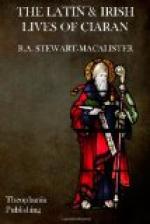The bell, called the boban of Coemgen, reappears much later in history as a relic on which oaths were taken (Annals of Clonmacnois, anno 1139; Four Masters, anno 1143). It was doubtless a relic preserved at Glendaloch, in which the people of Clonmacnois rightly or wrongly claimed a part-proprietorship. The name is obscure: it means, according to O’Davoren’s Glossary, a calf or little cow: and Plummer (VSH, i, p. clxxvii) suggests that this name may be an allusion to its small size. But why “calf”? Is it an allusion to the original use of the type of bells used for ecclesiastical purposes in Ireland, as cow-bells?
Angels were seen by Saint Colman to fill the space between heaven and earth to receive the soul of Pope Gregory (VSH, i, 264).
LI. THE EARTH OF CIARAN’S TOMB DELIVERS COLUM CILLE FROM A WHIRLPOOL (LA, LB)
This is perhaps an imitation of the tale of the Empress Helena, who, when returning after her discovery of the True Cross, was delivered from a storm by casting one of the Nails into the sea. Colum Cille was saved from the whirlpool of Coire Bhreacain (Corrievreckan, between Jura and Scarba) on another (?) occasion, by reciting a hymn to Brigit (LL, 1706).
The Visit of Colum Cille to Clonmacnois.—This took place during the rule of Ailithir, the fourth abbot of Clonmacnois (A.D. 589-595). It is described in Adamnan’s Vita Columbae, where we read of the honour paid to the distinguished visitor, and how he was greeted with hymns and praises, while a canopy was borne over him on his way to the church, to protect him from inconvenient crowding. A humble boy, a useless servitor in the monastery, came behind




